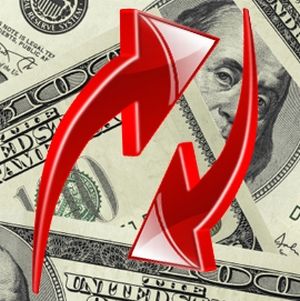
Publisher:
Bonnie King
CONTACT:
Newsroom@Salem-news.com
Advertising:
Adsales@Salem-news.com

~Truth~
~Justice~
~Peace~
TJP
Dec-18-2010 17:21

 TweetFollow @OregonNews
TweetFollow @OregonNews
Deflation, Inflation - Take Your Pick
Jeff Gates Salem-News.comWhy continue on the same path that enabled this fracturing of U.S. society?
 Photo courtesy: lynbockert.com |
(TEMPE, Az.) - U.S. stock markets rallied to recent highs on news that the U.S. Federal Reserve planned to pump up to $900 billion more cash into the economy. Financial markets reflect today’s appraisal of tomorrow’s cash flows. More cash means more flows.
Fed Chairman Ben Bernanke conceded early on in 2008 that the Fed was “printing money.” That candor proved unsettling. This latest cash infusion instead is “quantitative easing” or “QE2.”
“QE1” stabilized financial firms that cross-collateralized massive layers of debt and derivatives in a creative scheme that was destined to collapse without…more cash flow.
Insurance giant AIG booked profits by selling more than $440 billion in credit default swaps, a form of insurance, without setting aside reserves. That’s when the Fed stepped in with QE1.
Voicing his admiration for “financial creativity,” former Fed chair Alan Greenspan enabled this pyramiding of debt-on-debt with low interest rates and lax oversight during his 19-year tenure.
Greenspan concedes his high regard for Russian philosopher Ayn Rand (né Alisa Rosenbaum) who famously wore an oversized dollar mark as a broach. Her philosophy: grant money the freedom to work its will worldwide and everything will work out just fine.
Reflecting on the debt-induced financial carnage he helped create, Greenspan recently marveled that financial markets were not, as he and Rand believed, “self correcting.” How could this True Believer have been so mistaken? Why does his successor not yet see the problem?
Answer: both men share a mindset from which the problem cannot be seen because that mindset is the filter through which they do their seeing.
This money-myopic perspective, imbedded in American education over decades, first appeared in the U.S. as the “Chicago model.” The late University of Chicago Professor Milton Friedman, a Noble laureate economist, remains the patron saint of this “monetarist” perspective.
As this dollar-centric ideology was taken to global scale, it became the “Washington consensus.” Generally accepted truths are seldom revisited even when, as now, a reappraisal is long overdue.
Dollar Infatuation = Deflation or Inflation
The Fed is rightly worried that the economy is slipping into a debt-induced deflation akin to Japan’s “lost decade.” As the U.S. deleverages, it could face a similar fate. QE2 is meant to counter deflation yet it could trigger inflation. That’s the risk when banks start printing money.
WWII was triggered by an onerous reparations burden imposed on Germany at the Treaty of Versailles ending WWI. British economist John Maynard Keynes left those negotiations to publish a warning in 1919 titled The Economic Consequences of the Peace.
The resulting indignities of widespread poverty and hyperinflation fueled a hyper-nationalism from which emerged the fascist forces that ravaged Europe. The U.S. emerged with an industrial base that ensured its bonds would become the world’s preferred gilt-edged security.
Keynes surfaced in the 1930s to advocate the debt-financed stimulation of demand. The 1980s saw a debt-financed “supply-side” successor—to stimulate investment. Both boosted cash flows.
With lower tax rates and faster depreciation, this Reagan-era ideology was projected to reduce government revenues by $872 billion over five years. With this stimulus, the former actor catalyzed a three-decade debt binge further enabled by the easy credit era of Alan Greenspan.
When Reagan was elected in 1980, securitized U.S. debt totaled $900 billion. The total is now on track to top $15.4 trillion. By 2020, annual interest payments alone could top $1 trillion.
Monetization of What for Whom?
How long before this cash infusion fuels inflation? That depends on how these Fed-boosted bank reserves are deployed. In the interim we’ll see another massive skimming of financial value from yet another Fed-inflated equity market.
By fixating on how debt-backed dollars can revive a deflating economy, those who induced the U.S. to embrace this mindset may yet induce a debilitating inflation. The year 2013 is the 100th anniversary of the Fed. The solution lies in a willingness to view the problem anew.
Who decreed debt the only way to catalyze demand? Who says all purchasing power must be limited to one-size-fits-all Federal Reserve notes? Why not encourage complementary currencies attuned to the needs of regions and communities?
Ecologically, are Americans expected to shop their way to sustainable prosperity with debt-backed dollars? Rather than debt, why not monetize the physical capital required for a clean energy economy?
Americans are witnessing record-breaking disparities in wealth and income. Why continue on the same path that enabled this fracturing of U.S. society? Why not monetize a sustainable future with means that ensure a shared prosperity?
To solve this problem, first we must acknowledge how the U.S. was induced to embrace a mindset that requires more debt to create more purchasing power.
This problem can only be solved “upstream” commencing with a candid reappraisal of its origins in a shared mindset.
 Special thanks to: intifada-palestine.com
Special thanks to: intifada-palestine.com
Jeff Gates is a widely acclaimed author, attorney, investment banker, educator and consultant to government, corporate and union leaders worldwide.
Jeff's latest book is Guilt By Association — How Deception and Self-Deceit Took America to War (2008). His previous books include Democracy at Risk: Rescuing Main Street From Wall Street and The Ownership Solution: Toward a Shared Capitalism for the 21st Century. For two decades, an adviser to policy-makers worldwide. Counsel to the U.S. Senate Finance Committee (1980-87).
For more: information, visit: criminalstate.com You can email Jeff Gates at this address: jeffgates2@gmail.com
Articles for December 17, 2010 | Articles for December 18, 2010 | Articles for December 19, 2010
Quick Links
DINING
Willamette UniversityGoudy Commons Cafe
Dine on the Queen
Willamette Queen Sternwheeler
MUST SEE SALEM
Oregon Capitol ToursCapitol History Gateway
Willamette River Ride
Willamette Queen Sternwheeler
Historic Home Tours:
Deepwood Museum
The Bush House
Gaiety Hollow Garden
AUCTIONS - APPRAISALS
Auction Masters & AppraisalsCONSTRUCTION SERVICES
Roofing and ContractingSheridan, Ore.
ONLINE SHOPPING
Special Occasion DressesAdvertise with Salem-News
Contact:AdSales@Salem-News.com





Terms of Service | Privacy Policy

All comments and messages are approved by people and self promotional links or unacceptable comments are denied.
alty December 20, 2010 12:18 pm (Pacific time)
The mindset that created the mess we are in can be traced back to to conservatives taking advantage of the hyperinflation of the 1970s and early 80s. It was then that the conservatives realized inflation could be used to substantially reduce wages and at the same time make credit cheap. With wages falling, workers were forced to go into debt to bridge the gap between wages and cost. Then came the "ah-ha" moment for the right-wing. That "ah-ha" moment came to be known as the "Starving the beast fiscal-political strategy to use budget deficits via tax cuts to force future reductions in the size of government. The term 'beast' refers to the government and the programs it funds, particularly social programs such as welfare, Social Security, Medicare and public schools."
[Return to Top]©2025 Salem-News.com. All opinions expressed in this article are those of the author and do not necessarily reflect those of Salem-News.com.